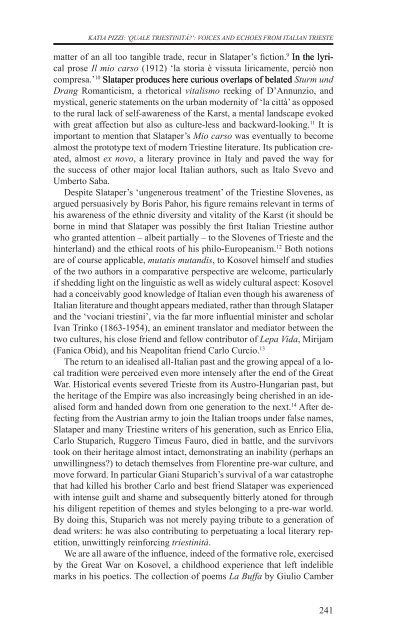razprave (pdf) - Društvo za primerjalno književnost - ZRC SAZU
razprave (pdf) - Društvo za primerjalno književnost - ZRC SAZU
razprave (pdf) - Društvo za primerjalno književnost - ZRC SAZU
- No tags were found...
You also want an ePaper? Increase the reach of your titles
YUMPU automatically turns print PDFs into web optimized ePapers that Google loves.
katia pizzi: 'QUALE TRIESTINITÀ?': VOICES AND ECHOES FROM ITALIAN TRIESTEmatter of an all too tangible trade, recur in Slataper’s fiction. 9 In the lyricalprose Il mio carso (1912) ‘la storia è vissuta liricamente, perciò noncompresa.’ 10 Slataper produces here curious overlaps of belated Sturm undDrang Romanticism, a rhetorical vitalismo reeking of D’Annunzio, andmystical, generic statements on the urban modernity of ‘la città’ as opposedto the rural lack of self-awareness of the Karst, a mental landscape evokedwith great affection but also as culture-less and backward-looking. 11 It isimportant to mention that Slataper’s Mio carso was eventually to becomealmost the prototype text of modern Triestine literature. Its publication created,almost ex novo, a literary province in Italy and paved the way forthe success of other major local Italian authors, such as Italo Svevo andUmberto Saba.Despite Slataper’s ‘ungenerous treatment’ of the Triestine Slovenes, asargued persuasively by Boris Pahor, his figure remains relevant in terms ofhis awareness of the ethnic diversity and vitality of the Karst (it should beborne in mind that Slataper was possibly the first Italian Triestine authorwho granted attention – albeit partially – to the Slovenes of Trieste and thehinterland) and the ethical roots of his philo-Europeanism. 12 Both notionsare of course applicable, mutatis mutandis, to Kosovel himself and studiesof the two authors in a comparative perspective are welcome, particularlyif shedding light on the linguistic as well as widely cultural aspect: Kosovelhad a conceivably good knowledge of Italian even though his awareness ofItalian literature and thought appears mediated, rather than through Slataperand the ‘vociani triestini’, via the far more influential minister and scholarIvan Trinko (1863-1954), an eminent translator and mediator between thetwo cultures, his close friend and fellow contributor of Lepa Vida, Mirijam(Fanica Obid), and his Neapolitan friend Carlo Curcio. 13The return to an idealised all-Italian past and the growing appeal of a localtradition were perceived even more intensely after the end of the GreatWar. Historical events severed Trieste from its Austro-Hungarian past, butthe heritage of the Empire was also increasingly being cherished in an idealisedform and handed down from one generation to the next. 14 After defectingfrom the Austrian army to join the Italian troops under false names,Slataper and many Triestine writers of his generation, such as Enrico Elia,Carlo Stuparich, Ruggero Timeus Fauro, died in battle, and the survivorstook on their heritage almost intact, demonstrating an inability (perhaps anunwillingness?) to detach themselves from Florentine pre-war culture, andmove forward. In particular Giani Stuparich’s survival of a war catastrophethat had killed his brother Carlo and best friend Slataper was experiencedwith intense guilt and shame and subsequently bitterly atoned for throughhis diligent repetition of themes and styles belonging to a pre-war world.By doing this, Stuparich was not merely paying tribute to a generation ofdead writers: he was also contributing to perpetuating a local literary repetition,unwittingly reinforcing triestinità.We are all aware of the influence, indeed of the formative role, exercisedby the Great War on Kosovel, a childhood experience that left indeliblemarks in his poetics. The collection of poems La Buffa by Giulio Camber241
















